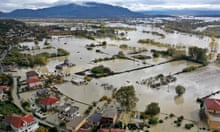All eyes are on the UK’s crucial winter weather forecast as the temperatures will affect how households manage their energy bills.
Long-term weather forecasting is notoriously difficult, but forecasters can come up with a broad sense of the weather in the months ahead. For those trying to reduce their bills this winter, the impact of a cold or mild winter will be huge in terms of energy use, said Christopher O’Reilly of the department for meteorology at the University of Reading.
“In the UK, winter temperatures have a strong impact on the demand for gas and electricity,” he said. “For example, a winter with a 1C temperature anomaly results in roughly a daily average gas demand anomaly of 100 GWh over a winter season.
“In monetary terms, based on the UK October gas price cap (10.3p a kWh), this equates to about £1bn for each 1C UK temperature anomaly … the numbers are pretty big, and the stakes are pretty high.”
The latest long-term Met Office forecast, therefore, will be welcome news for households across the UK. Prof Paul Davies, Met Office fellow (meteorology) and chief meteorologist, predicts a mild late autumn and early winter, with periods of wet, windy weather predominantly in the north and west.
But the impact on energy bills may not last, because once winter sets in as November turns to December, there could be a cold snap, with the threat of snow and ice, particularly in the north.
Milder conditions, however, are likely to take over once more into 2023, and Davies said the chances of a very cold winter, comparable to 2009-10, were low this winter.
“The most likely scenario as we head into 2023 is for the risk of high-pressure to decrease, and a return to more unsettled conditions with wet, windy and mild spells possible,” he said.
The main influence on European winter weather is the North Atlantic Oscillation. Positive phases correspond to windy, mild and wet conditions, while negative phases relate to still, cold and dry weather, which means we can obtain some indication of how likely a windy winter is. Another global factor that could influence the UK this winter is La Niña: a cooling of the ocean in the tropical Pacific, leading to high pressure in the Atlantic in late autumn and early winter, and potential cold snaps for the UK.
“Long-range outlooks are unlike weather forecasts which cover the next few days,” said Davies. “The science in this area is at the cutting edge of meteorology and the Met Office is one of the leading lights in this research area. Even with ‘perfect’ prediction systems and ‘perfect’ meteorological observations, the fundamental chaotic nature of the atmosphere will still limit the skill of these predictions.”









